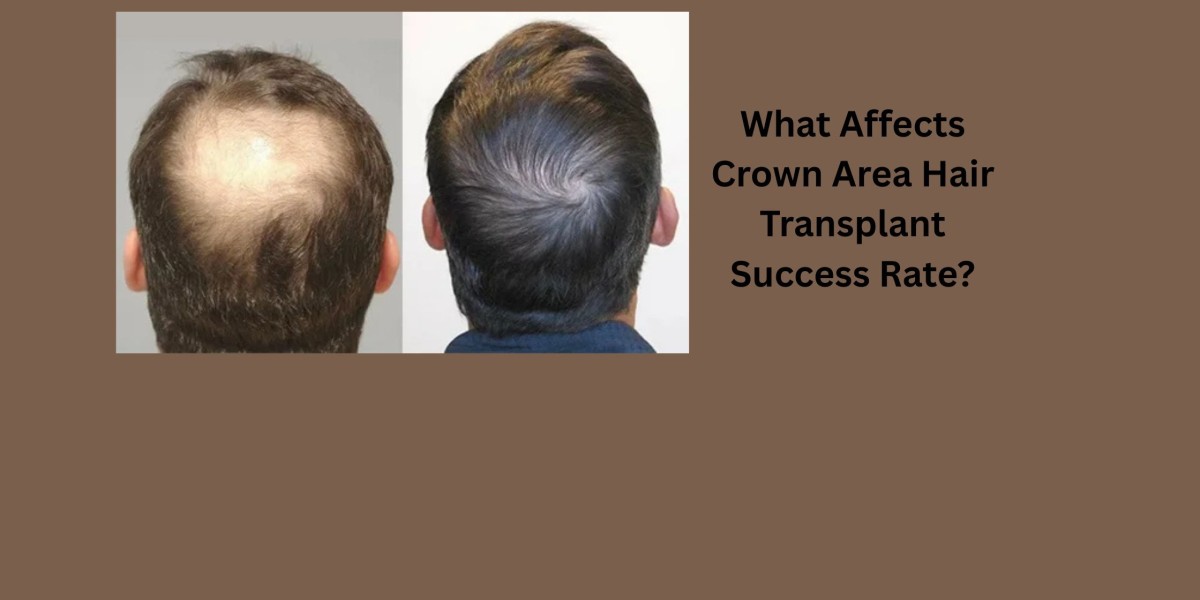Many people are concerned about hair loss in the crown area or the vertex. Due to its distinctive circular growth pattern and lower blood circulation, performing a hair transplant in this region can be especially challenging. Comprehending the key aspects influencing the Hair transplant crown area success rate is vital for attaining the most effective and natural-looking results.
Understanding the Crown Area
The crown area is located at the top and back of the head and is characterized by a natural swirl or whorl pattern. This distinct growth pattern requires meticulous planning and execution during hair transplantation to ensure the transplanted hair blends seamlessly with the existing hair. Additionally, the crown area typically has lower blood circulation than other parts of the scalp, affecting the survival and growth of transplanted follicles.
Factors Affecting Crown Hair Transplant Success Rate
Extent of Hair Loss
The severity of hair loss in the crown area significantly impacts the success rate of a hair transplant. Patients with extensive baldness may require a more significant number of grafts to achieve the desired density, which can strain the available donor hair supply. Moreover, ongoing hair loss can affect the long-term results, necessitating careful planning to accommodate future thinning.
Donor Area Quality
The quality and density of hair in the donor area (usually the back and sides of the scalp) are critical determinants of transplant success. A robust donor area provides healthy follicles more likely to survive and thrive after transplantation. Conversely, a weak donor area may limit the number of viable grafts, affecting the overall outcome.
Surgeon’s Skill and Experience
The success of a crown hair transplant greatly depends on the surgeon's skill. An experienced surgeon can accurately replicate the crown's natural swirl pattern, ensuring that the transplanted hair grows in the correct direction and angle. Precision in graft placement minimizes trauma to the scalp and enhances the aesthetic results.
Hair Transplant Technique Used
The choice between Follicular Unit Extraction (FUE) and Follicular Unit Transplantation (FUT) can influence the success rate. Individual hair follicles are extracted during FUE, which reduces scarring and speeds up recovery. On the other hand, FUT removes a scalp strip to harvest follicles, which may be more suitable for patients requiring many grafts. The selection of techniques should be tailored to the patient's specific needs and hair loss characteristics.
Graft Survival Rate
The survival of transplanted grafts is essential for achieving the desired density and coverage. Factors such as the handling of grafts during extraction and implantation, the time they spend outside the body, and the recipient area's blood supply can affect graft survival. Reduced blood circulation can pose challenges in the crown area, making meticulous surgical technique and post-operative care vital.
Patient’s Age and Genetics
Younger patients may experience progressive hair loss, which can impact the longevity of transplant results. Genetic factors contributing to hair loss also influence the overall success of a hair transplant. A thorough evaluation of the patient's family history and hair loss pattern is necessary to set realistic expectations and plan for potential future procedures.
Post-Operative Care
Adherence to post-operative instructions is crucial for graft survival and overall success. Patients should avoid strenuous activities, protect the scalp from trauma, and follow prescribed medication regimens. Proper aftercare is essential for reducing the risk of infection and promoting optimal healing, and it directly impacts the success rate of a crown area hair transplant.
Realistic Expectations
It's critical to comprehend a crown hair transplant's restrictions and possible results. Achieving full density in the crown area may require multiple sessions, and the final results can take up to 12-18 months to become apparent. Setting realistic goals helps ensure patient satisfaction and reduces the likelihood of disappointment.
Challenges Specific to Crown Transplants
The crown area's unique characteristics present specific challenges in hair transplantation. The natural swirl pattern requires precise replication to achieve a natural look. The larger surface area and reduced blood supply can also affect graft survival and growth. These factors necessitate careful planning and execution by experienced surgeons to maximize the success rate of crown area transplant.
Tips to Improve Crown Transplant Success Rate
- Choose a Qualified Surgeon: Select a surgeon with extensive experience in crown hair transplants and a track record of successful outcomes.
- Stabilize Hair Loss: Consider medical treatments like Finasteride or Minoxidil to slow or halt hair loss before surgery.
- Plan for the Future: Discuss potential hair loss and plan accordingly to ensure long-term satisfaction.
- Follow Post-Operative Instructions: Adhere strictly to the surgeon's aftercare guidelines to promote healing and graft survival.
- Maintain Realistic Expectations: Understand that achieving the desired density may require multiple sessions and that final results take time to manifest.
Conclusion
Several important factors influence the success of a hair transplant in the crown area, such as the area of hair loss, the rate and availability of donor hair, the accuracy of the surgical technique, and consistent post-operative care. At Beverly Hills Hair Restoration, our expert team is committed to delivering personalized treatment and utilizing the latest advancements to enhance the success rate of crown area hair transplants. Schedule a consultation with us to discover the most effective options for your hair restoration journey.




